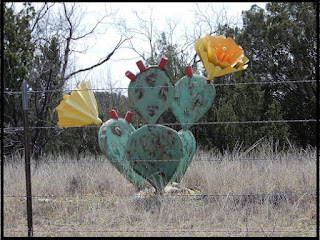Small roads took us through some little tiny
towns and one caught my
interest: Aspermont. It reminded me of aspirin, aspirgum,
asparagus, asti spumante, and a host of other sound alike words. I certainly
hadn’t heard of the town and didn’t expect to actually go through it. However,
as the road curved we drove into this mini-metropolis. Surprisingly it is the
seat of Stonewall County. This county has less than 1,400 people and is
dwindling; Aspermont had 855 people as of 2017.
The early history of Stonewall County mirrors that of Young, Throckmorton, and Haskell Counties: Spanish explorers, military, Plains
tribes, buffalo, cattle and farming. In 1876, fifty-four counties were formed
by the Fifteenth Texas Legislature from the Young and Bexar districts; Stonewall
County was one of them. It is named for Thomas
Jonathan ‘Stonewall’ Jackson, a famous general of the Confederate States Army.
Stonewall County remained attached to Young County for all governmental functions
until 1887, when it was assigned to Jones County. Then, in 1888, the residents petitioned
the Jones County Commissioners Court to hold an election for county organization.
In 1889, W. E.
Rayner received a land grant to establish the town of Rayner; this became
the county seat. The courthouse, a large stone building, was built that year; Stonewall
County has had 5 courthouses with the first two being located in Rayner; the
second courthouse was built in 1891.
Economics increased, as did the population throughout the 1890s, but not
necessarily in Rayner. Also in 1899 A. L. Rhomberg
platted the town of Aspermont,
which as it turned out, was closer to the center of the county. The city
citizens began, in 1892, petitioning for the town to become the county seat
partially because of the rapid population increase. After a bit of conflict,
Aspermont was named the county seat in 1892. In Latin Aspermont translates to ‘rough
mountain, and may refer to the nearby Double Mountains. A new courthouse was begun
in 1900 in Aspermont was signed; this rang the death knell for Rayner. The 1891
courthouse is in the ghost town of Rayner as a private residence. A new
courthouse was constructed in 1911, again in Aspermont. Marshall Formby, who later
became a Texas state senator, ran the Aspermont Star weekly newspaper in the
mid- 1930s; it’s now called the Double
Mountain Chronicle. The final courthouse was designed by Lubbock architects
Mills
and Davis in 1983; it is loosely based on designs by Frank Lloyd Wright.
©2019 NearNormal Design and Production Studio - All rights including copyright of photographs and designs, as well as intellectual rights are reserved.
 |
| Cactus sculpture |
The early history of Stonewall County mirrors that of Young, Throckmorton, and Haskell Counties: Spanish explorers, military, Plains
 |
| Stonewall County courthouse and statue |
Economics increased, as did the population throughout the 1890s, but not
 |
| Bank building |
 |
| Aspermont beach? |
©2019 NearNormal Design and Production Studio - All rights including copyright of photographs and designs, as well as intellectual rights are reserved.
No comments:
Post a Comment